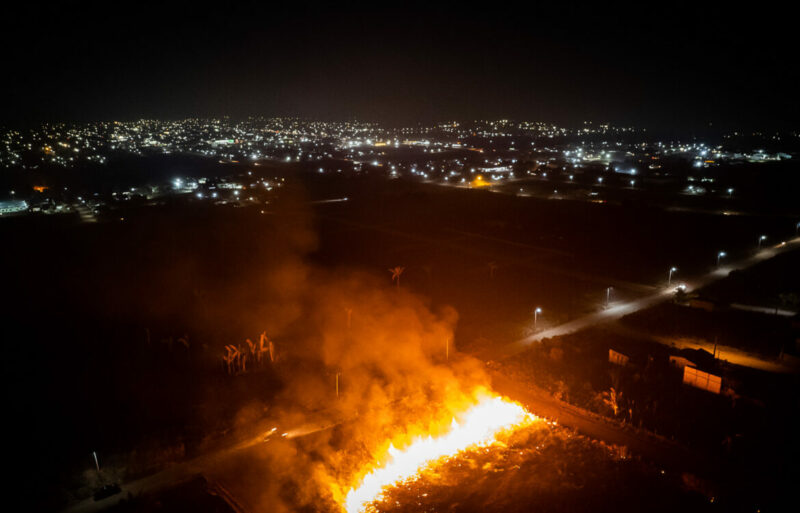
Fire in the urban area of Novo Progresso, Pará state | Photo: Cícero Pedrosa Neto/Amazônia Real
This report, written by Cícero Pedrosa Neto, was published on Amazônia Real's website on September 20, 2022. It is republished by Global Voices under a partnership agreement, with updates and edits to the original text.
With backpacks in her hands, Maria Margareth Silva, 67, a Jair Bolsonaro (PL, Liberal Party) voter, was waiting for her bus at the Novo Progresso bus station. It was the morning of September 3, although it did not seem like it.
Suffocated by a dense fog of smoke and soot, caused by pollution from fires in the surrounding forests, the town in the northern state of Pará sees some days that seem like nights. The thick layer of particulate materials and toxic gases makes the air unbreathable. While talking to the reporter, Silva could hardly speak, coughing repeatedly.
“I'm going to spend a few days in the house of some relatives in Uruará (a neighbouring town) to get away from the smoke,” she said. Unlike other local residents, she says that she cannot stand to live with the effects of the fires.
Novo Progresso is one of the towns with the highest rates of forest fires, deforestation, and support for president Bolsonaro, seen as promoting devastation in the Amazon.
“At this time of the year, it's like this. We can't even see the sky. The sun is just a red torch. Our breathing is tight. As long as the rain doesn't come, it'll be like this,” she said, referring to the beginning of the rainy season, usually in November.
In Novo Progresso, the only flags that can be seen support Bolsonaro, and almost always next to the Brazilian flag, the national symbol hijacked by the ultranationalism propagated by the current president.
The town of Novo Progresso is ranked tenth in greenhouse gas emissions in Brazil. It emits about 580 tons of CO2 per inhabitant every year, according to data from the Climate Observatory. This is more than 80 times the average of the world population, which is around 7 tons per inhabitant every year.
“It is as if each inhabitant of Novo Progresso had more than 500 cars running 20 kilometres a day on petrol,” the report said.
Smoke in the Amazon
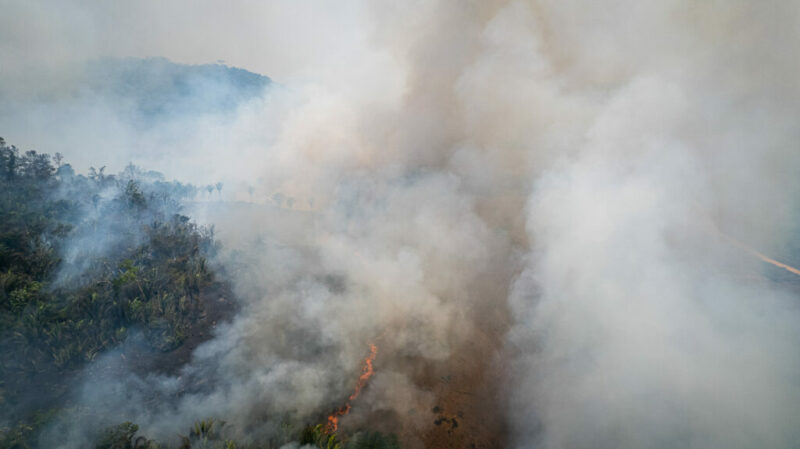
Fire breaks out along the Paraná side road, an access road to the Baú Indigenous Land, of the Kayapó people, in Novo Progresso (PA) | Photo: Cícero Pedrosa Neto/Amazônia Real
According to Inpe (National Institute for Space Research), from January to September 18, 24,034 fires were registered in the state of Pará, surpassing 2020 (23,507 fires), and 2019 (15,776 fires).
Novo Progresso is one of the towns responsible for sending toxic smoke from the burning fires in the Amazon to the Southeast and South regions of the country. The residents say that there are two seasons in the city: the rainy season and the fire season.
The city became known for the “day of fire,” a movement organized on WhatsApp, on August 10, 2019. The perpetrators — mostly farmers and grileiros (invaders of lands) — wanted to get Bolsonaro's attention to call for the end of Ibama (Brazilian Institute of Environment and Renewable Natural Resources) inspections in the town and in the conservation areas that are in its territory.
They set fire to a vast area of forest, which spread to nearby towns. In two days, Inpe recorded 1,457 fires in Pará. In 2022, a new “day of fire,” on August 22, saw 2,238 fires, according to the institute.
The report observed the advance of fire on the edges of the Indigenous Land of the Kayapó people, around Kamau village.
“Every year we gather the warriors to prevent fire from entering our territory. It's difficult, we try to talk to the farmers, but they don't listen. Look at how it ended up,” says Bepdjyre Kayapó, leader of Kamau village, pointing to the burned area that encroached on the Indigenous territory.
Not even the sign of the National Indigenous Foundation (FUNAI) that marks the beginning of the territory escaped the fire.
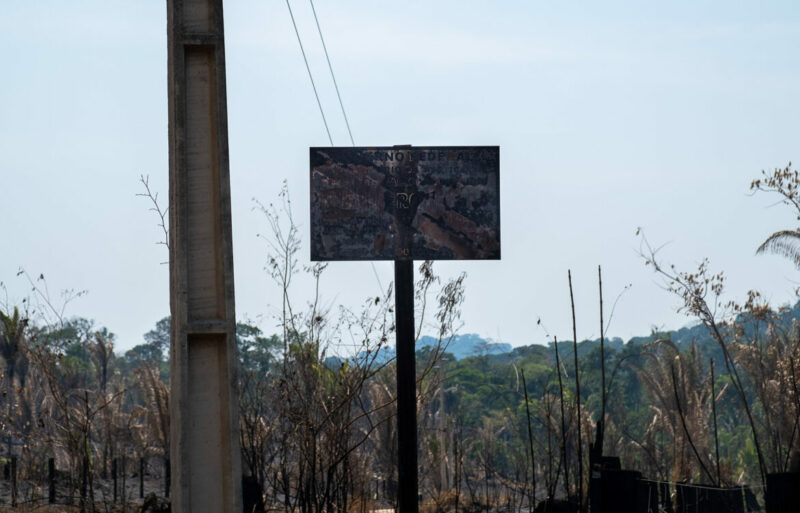
Funai sign burned by fire on the edges of the IT Baú | Photo: Cícero Pedrosa Neto/Amazônia Real
“They [Funai] don't have the means to control how far the fire will spread. So it ends up entering Indigenous land, forcing the residents to be on alert, always waiting for the worst,” said a source, who did not want to be identified.
For years, other protected territories in areas around 38,000 kilometres of the municipality have been suffering from the systematic advance of land grabbers, loggers, and miners.
At this time, a cloud of smoke covers the streets, houses, schools, and hospitals, with nowhere to escape. People avoid wearing white, and the soot lands on family homes and clothes on clotheslines.
The hot air, caused by the fires, affects the throat, the trachea, and the lungs. Coughing and respiratory fatigue already begin to be felt in the first few hours of staying in the city.
A climate of despair
From January to September 18, 2022, Novo Progresso recorded 3,083 fires, according to Inpe.
“It seems that everybody decided to set fires at the end of August, beginning of September. I think people are afraid and are going into the forest with everything without thinking about tomorrow,” said researcher Ane Alencar.
“It could be a reflection of the election process we are going through,” she said, referring to Bolsonaro being behind in the polls.
The president finished the first round behind former president Luiz Inácio Lula da Silva (PT, Workers’ Party), with a difference of 6 million votes. In Pará, Lula received 52.2 percent of the votes, and Bolsonaro 40.2 percent. In Novo Progresso, however, the current president was well ahead, with 79.6 percent against 17.5 percent.
In the second round, with Lula elected, Bolsonaro got 82.9 percent of the votes against 17 percent for Lula in this municipality.
“The triumphalism of agribusiness, excited about Bolsonaro in 2019, has been replaced by a desperation to do everything quickly and as much as possible, faced with the prospect of his defeat in the elections,” said Alfredo Wagner Berno de Almeida, coordinator of the research group Nova Cartografia Social da Amazônia (New Social Cartography of the Amazon).
The researcher also highlighted another factor to understand why Novo Progresso prefers Bolsonaro. Located in a strategic position on the map, it is part of the route of a major transportation project, Ferrogrão.
The 933-kilometre railway, which has yet to be developed, is sold as a solution for the flow of agribusiness products, connecting the city of Sinop, in Mato Grosso, to the centre of soybean and corn production in Itaituba, in Pará, on the banks of the Tapajós river.
Pro-Bolsonaro delirium
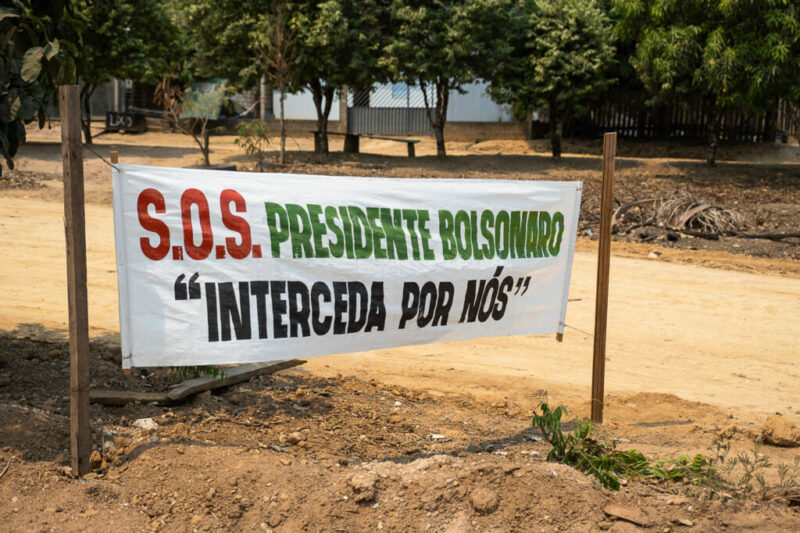
A sign alongside the BR-63 highway calls for the intervention of president Jair Bolsonaro to not let a Federal Traffic Police station be built | Photo: Cícero Pedrosa Neto/Amazônia Real
In the “hell” of Novo Progresso, one can hear Bolsonaro's voice on street corners, in garages and markets, from videos sent via WhatsApp and downloaded from Wi-Fi in private establishments — the telephone service in the region is unreliable. The Wi-Fi password? In several cases, “Bolsonaro 2022.”
Because of the fires, posts and fibre optic cables, which transmit the internet signal to the almost 26,000 inhabitants, were affected, while Amazonia Real reporting was there.
The president's image has been merged with the logos of some local businesses, car repairs, petrol stations, bars, and restaurants. His face is also on the 4×4 vehicles and SUVs that speed around, throwing up dust and making the air even more unbreathable.
Even with dozens of scientists, satellites, and the visible impacts showing that Novo Progresso is a symbol of the Amazon's devastation, in the city the idea persists that the data are nothing more than “stories.” That was the term used by Agamenon Meneses — president of the Union of Rural Producers of Novo Progresso, and investigated by the Federal Police as one of those responsible for organizing the “day of fire” in 2019 — when speaking to the reporter.
Isso aí é uma farsa muito grande, muita conversa fiada, muita invenção, muita narrativa, entendeu? […] Todo ano tem uma estatística de desmatamento e se você considerar essa quantidade, já tinha acabado a mata amazônica; já tinha acabado tudo.
[…]
Desmatamento há, uns pequenos pedaços de área que a pessoa quer implementar pasto, dentro do limite constitucional de 20%. Aí, quando queima essa área, cria uma fumaceira danada, porque é abafado, não corre vento.
This is a big farce, a lot of nonsense, a lot of fabrication, a lot of stories, you understand? […] Every year there’s a deforestation statistic and if you go with this amount, the Amazon forest would have already disappeared; everything would have disappeared.
[…]
There is deforestation, some small pieces of land that somebody wants to clear for pasture, within the constitutional limit of 20%. Then, when they burn this area, it creates a crazy amount of smoke, because it's airless, there's no wind.
A former resident of Novo Progresso told the reporter that there is a “faith in Bolsonaro” that makes local farmers led by Agamenon believe that the president will change Brazil's environmental laws. They also believe that fines imposed by enforcement agencies will receive an amnesty from Bolsonaro.
Full support
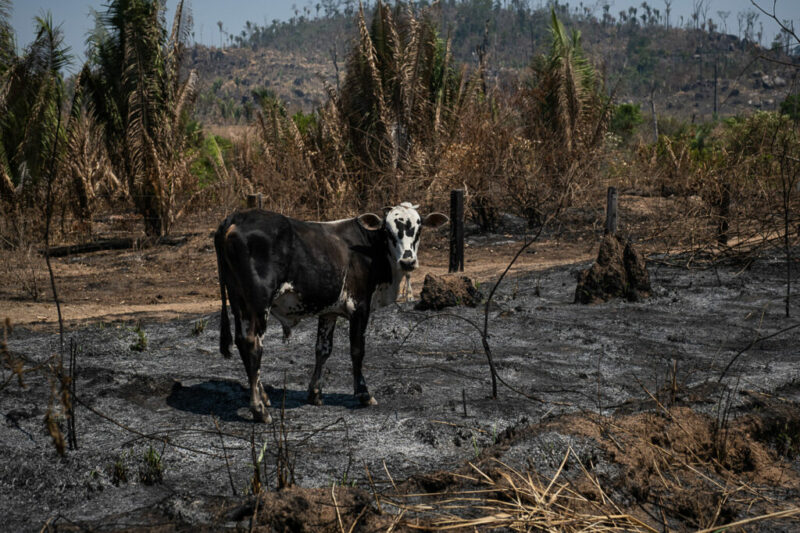
Cattle in the middle of a burned area along the Paraná side road, access road to the Baú IT, of the Kayapó people | Photo: Cícero Pedrosa Neto/Amazônia Real
According to the municipal secretary for the Environment in Novo Progresso, João Maria dos Santos, there have been no unusual deforestation or fires this year. He calls for changes in the country's environmental legislation and a reduction in the number of environmental and Indigenous reserves in the area.
Amazônia Real also requested comment from Pará state’s government about the fires in Novo Progresso and environmental policies, as Governor Helder Barbalho is the representative of the governors of the Legal Amazon for climate issues, but received no response. Barbalho was re-elected and supports Lula.
The report also tried to contact Ibama, but received no reply as of publication.
Impunity
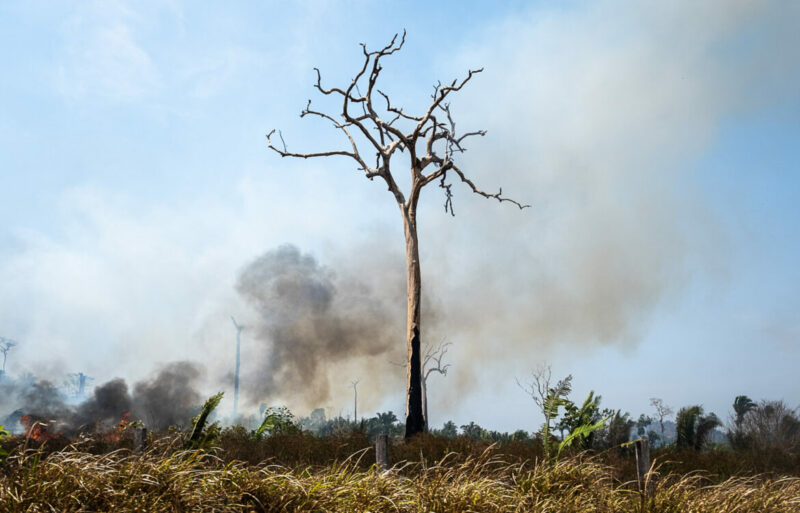
Fires along the Paraná side road, access road to the Baú Indigenous Territory, of the Kayapó people, in Novo Progresso (PA) (Photo: Cícero Pedrosa Neto/Amazônia Real)
Under Bolsonaro's government, Novo Progresso has reached historic levels of destruction. Between 2019 and 2021, the town recorded about 972 square kilometres of deforestation, the equivalent of 97,200 football fields, according to data from Inpe.
Researcher Ane Alencar, from IPAM (Amazon Research Institute), explained that deforestation and fires are inseparable, one following the other. In other words, deforestation leads to the burnings and, consequently, in forest fires, which become more frequent between August and September every year in the region.
“Novo Progresso is one of the centres of deforestation and burning in the region, a territory where crime apparently pays”, Ane Alencar comments, referring to non-compliance with the Brazilian Forest Code.
The scenario, however, is not limited to this municipality that, in September, ranked fifth in the number of fires among 10 municipalities in the Legal Amazon.
The Amazon recorded its worst average number of fires in 2022, since Inpe began monitoring the fires in the Amazon in 2012.






